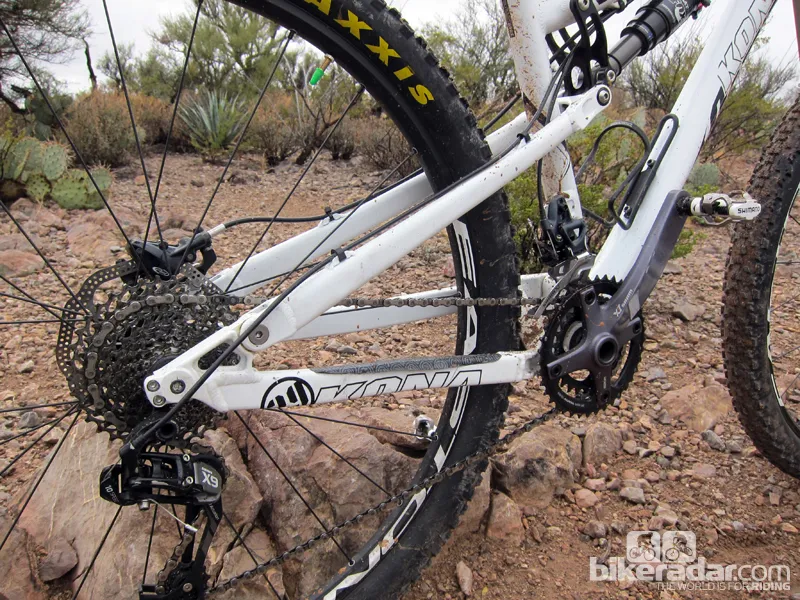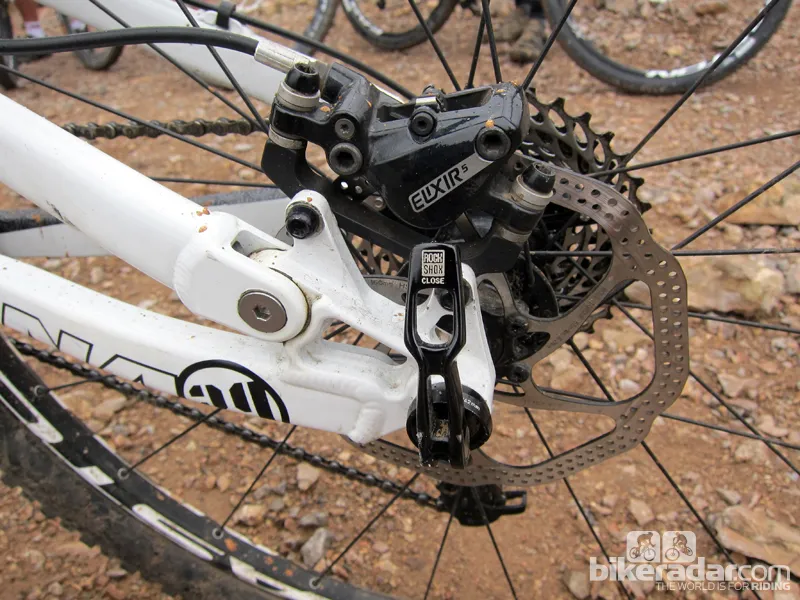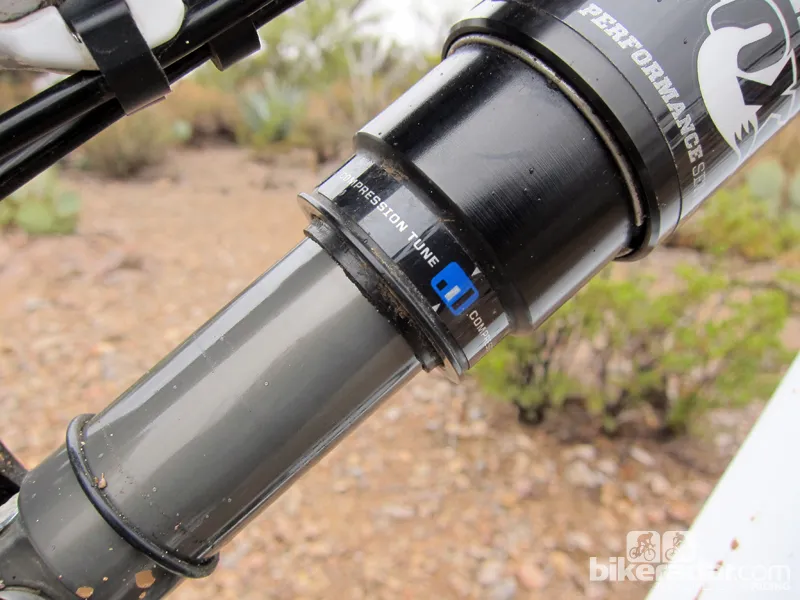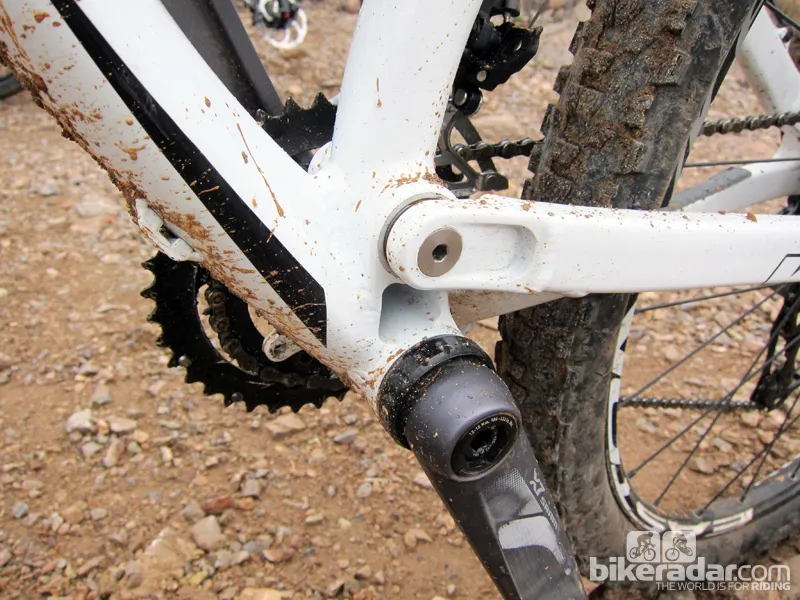The new Kona Satori melds 130mm of travel at each end with big, fat 29in rubber, which all combines with well sorted geometry to yield a highly entertaining two-wheeled monster truck. It's not necessarily the most invigorating rig at slower speeds but ramp up the velocity and it really comes alive.
Ride & handling: Competent suspension, great angles
The Satori's smart frame geometry is best appreciated when motoring in the big ring or attacking fast, swoopy singletrack descents. The 68-degree head tube angle strikes an excellent balance between high-speed stability and overall agility, while the relatively low 338mm bottom bracket lets you sink your weight into the bike for confidently railing corners and controllable two-wheel drifts.
Good overall frame stiffness – aided by front and rear through-axles – lends additional predictability to the handling, too, especially in trickier situations when the front end is heavily loaded.
Despite the progressively slack front end, wheelbase is kept to a still-manageable 1,150mm thanks to super-short 440mm chainstays (shorter than some 26in-wheeled hardtails, in fact). This not only helps keep the Satori from feeling too big but also makes it surprisingly easy to loft the front end for manuals and clearing obstacles – a key criticism of 29er trail bikes that the Satori handily avoids.
Kona tap their tried-and-true linkage-activated single-pivot rear suspension layout for a linear-feeling and well-controlled stroke that sucks up most bumps without overly isolating you from the trail but don't expect it to blow your socks off when compared to some more sophisticated systems out there.

Kona stick to their tried-and-true faux-bar single pivot suspension design for the new Satori
The main pivot is aligned with the inner ring and the Fox RP2 rear shock is specced with medium levels of compression damping, so pedal bob is negligible in the right gear. As a result, the Satori efficiently makes its way up climbs if you're content to sit and spin – in fact, we didn't frequently feel the need to engage the ProPedal lever in those situations.
Big-ring motoring or power climbs are a different story, however, as the Satori noticeably wallows unless ProPedal is engaged. In addition, that extra compression damping somewhat hampers suspension activity on smaller bumps and trail buzz. Regardless, Satori buyers probably shouldn't expect to set any personal bests for acceleration.
The complete package is a reasonable weight at around 13.6kg (30lb, claimed) but the chunky Easton Vice 29er wheels and giant 2.4/2.25in-wide Maxxis Ardent folding tires aren't exactly feathery (more on this later). Make no mistake, the Satori will go if you ask it to – in fact, we even chalked up a KOM on Strava during our test ride – but it's best to wind it up rather than expect it to leap forward with each pedal stroke.
Frame: Burly butted alloy construction with modern features
The all-new frame is fitted with a thoroughly modern laundry list of features. Butted 7005 aluminum tubing is used throughout (with additional hydroforming in a few spots), the asymmetrical rear end pivots on sealed cartridge bearings and there's a tapered head tube up front with internal bearings to lower the stack height.
The front derailleur directly mounts to a seat-tube-mounted block for easier and more consistent positioning, and the rear end is bolstered with a 12x142mm RockShox Maxle through-axle. Kona use aluminum for the dramatically milled-away shock link as well, and full-length housing is secured to the underside of the top tube with additional guides for a dropper seatpost.

Through-axle rear dropouts help bolster the back end on the new Kona Satori
The threaded bottom bracket is milled as one piece with an integrated swingarm main pivot and ISCG 05 tabs – which, should you be so inclined, can even be filled with a Truvativ HammerSchmidt along with the accompanying down tube guides. Claimed frame weight is 3.54kg (7.8lb) for a 22in size with rear shock, seatpost collar and rear axle.
Equipment: Solid drivetrain and brakes but so-so wheels
Kona peg the Satori as a "working man's bike" and dip heavily into the SRAM parts bins for a solid build kit that gets the job done but won't break the bank. The X7/X9 2x10 drivetrain was smooth running and shifted precisely, and the Avid Elixir 5 disc brakes (with 180/160mm front/rear rotors) provided plenty of power and good modulation, albeit with some noise under hard braking.
Last year's Gutter bottom bracket redesign has been holding up well on other test bikes, with good weather sealing and impressively low-friction running so we're optimistic the Satori's will, too. We're also crossing our fingers that the latest crop of Avid Taperbore brakes has finally squelched any lingering reliability issues. They're great brakes when they're working so hopefully they'll stay that way long-term.
As with previous encounters, the RockShox Revelation RLT 130mm fork with 20mm through-axle dropouts was outstanding. The smooth and well-controlled stroke boasts admirably low stiction and a suitably progressive spring rate, the chassis is respectably stiff considering the generous travel and long legs, and as always, the Dual Air spring system is highly adjustable – no complaints here at all.
We have mixed opinions on the rolling stock, however. The OEM-only Easton Vice wheelset boasts a generous 23mm internal rim width, adding even more volume to the meaty 2.4/2.25in-wide Maxxis Ardent tires. Run at just 23/25psi front/rear, we enjoyed impressive dry-conditions grip, lots of float, and forgiving drift characteristics while still rolling admirably quickly for such a big set of rubber.

The Easton Vice 29er wheels are built with wide rims for extra stiffness and volume but they're not particularly light at a little over 2kg per set
Our particular test bike was hampered by Slime self-sealing tubes weighing near a pound each but even in factory form, the Satori's rolling stock isn't especially eager to spin up. The wheels are over 2kg a set and when taken all together with tires and standard tubes (the Vice wheels aren't readily tubeless-compatible) add up to a whopping 4kg package.
The freehub body developed an unnerving amount of pinging and popping under load toward the end of the ride, too, which didn't instill a lot of confidence. Save for the awesomely comfy WTB Valcon saddle, the rest of the finishing kit comes from Kona's house brand. Nothing stood out (good or bad) on the alloy stem or seatpost but we'd have preferred to a see a wide, flat bar instead of the low-rise model specified.
Though the head tube length is identical to that of the Hei Hei 29 Supreme, the Satori sports 30mm more fork travel but roughly the same bottom bracket height. As a result, the front end feels a bit high and it occasionally took a bit more work to load the front end in corners. Finally, the lock-on grips offer excellent bar feel and a small diameter but they're very hard.
Conclusion
While not superlight or built with a groundbreaking suspension technology, our initial three-hour test ride in the Arizona desert suggests the Kona Satori is a solid middle-of-the-road 29er package. (We're going to hold off giving it a score until we've put some more miles in on it.) You can see it in action in the video below, from Kona:
Unable to load media







